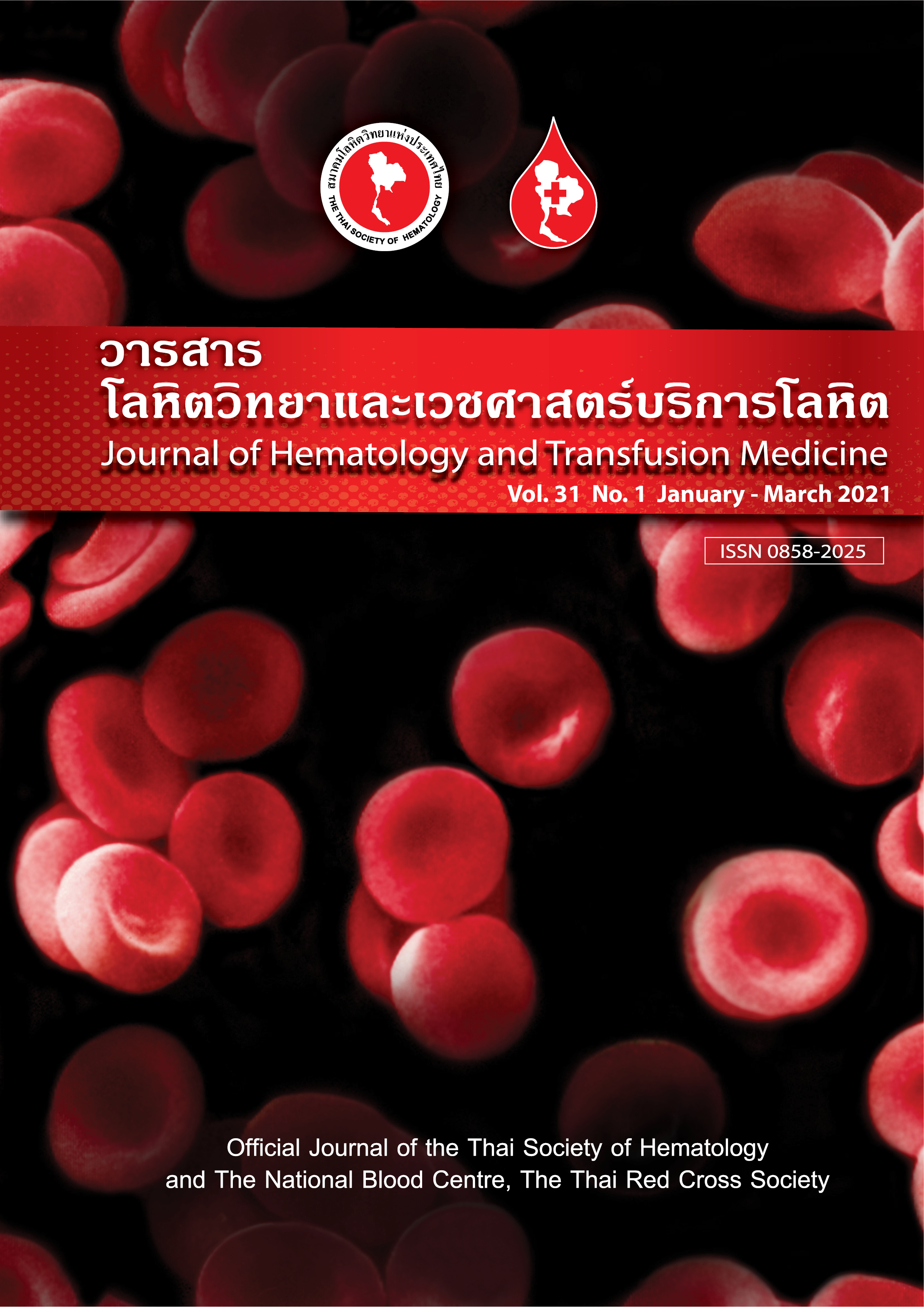Therapeutic plasma exchange as a treatment of a dengue encephalopathic patient
Keywords:
Therapeutic plasma exchange, Dengue encephalopathy, ApheresisAbstract
Abstract:
Introduction: Dengue virus is a global burden affecting about 390 million people annually. Neurological complications were found in a broad range of 0.5-21% of dengue-infected patients. Dengue encephalopathy and encephalitis have a fatality rate of 22%. There is currently no specific treatment. Therapeutic plasma exchange is recommended as one of the possible alternative treatments. However, to our knowledge, there has been no published record of therapeutic plasma exchange in severe dengue patients. Here, we present a dengue encephalopathy case successfully treated with therapeutic plasma exchange. Case report: A 39-year-old male with no known underlying disease presented at the Emergency Department with hematemesis for one hour. A diagnosis of dengue infection with acute liver failure and upper gastrointestinal tract bleeding was given. He developed alteration of consciousness and focal to generalized tonic-clonic seizure. He was diagnosed of dengue encephalopathy because he had impaired consciousness, seizure, hepatic failure, and normal CSF. The Blood Bank was consulted for the therapeutic plasma exchange and was done for a total of three times. Thereafter, the patient’s Glasgow coma score improved. The patient did not convulse again. His platelet count reached 136,000 /mm3 and was eventually discharged. On follow-up, he had not convulsed again and had no fever. Conclusion: We report a case of dengue encephalopathic patient successfully treated with therapeutic plasma exchange which decreased the levels of the inflammatory cytokines and pathological antibodies from the plasma. The patient improved dramatically after the first therapeutic plasma exchange.
บทคัดย่อ
บทนำ ไวรัสเดงกีเป็นสาเหตุของโรคไข้เลือดออกทั่วโลกปีละ 390 ล้านคน พบภาวะแทรกซ้อนทางระบบประสาทได้ใน 0.5-21% ในผู้ติดเชื้อไวรัสเดงกี Dengue encephalitis และ encephalopathy มีอัตราป่วยตาย 22% ปัจจุบันยังไม่มีวิธีรักษาที่จำเพาะ therapeutic plasma exchange เป็นวิธีการรักษาหนึ่งที่เป็นไปได้ อย่างไรก็ตาม ณ ปัจจุบันยังไม่มีรายงานผู้ป่วยติดเชื้อเดงกีรุนแรงที่ได้รับการรักษาด้วย therapeutic plasma exchange บทความนี้รายงานการรักษาผู้ป่วย Dengue encephalopathy รายหนึ่งด้วย therapeutic plasma exchange ที่ประสบความสำเร็จ รายงานผู้ป่วย ผู้ป่วยชายอายุ 39 ปี ไม่มีโรคประจำตัวมาที่ห้องฉุกเฉินด้วยอาการอาเจียนเป็นเลือดมา 1 ชั่วโมง ได้รับการวินิจฉัยเป็นโรคไข้เลือดออกร่วมกับภาวะตับวายเฉียบพลันและภาวะเลือดออกในทางเดินอาหารส่วนบน ผู้ป่วยมีอาการซึมลงตามมาด้วยอาการชักเฉพาะที่ ต่อมามีอาการชักทั้งตัว ผู้ป่วยได้รับการวินิจฉัยว่าเป็น Dengue encephalopathy เนื่องจากมีอาการซึม อาการชัก ภาวะตับวาย และการตรวจน้ำไขสันหลังปกติ ธนาคารเลือดได้รับการปรึกษาเพื่อทำ therapeutic plasma exchange เป็นจำนวน 3 ครั้ง ภายหลังการทำพบว่าแบบประเมินความรู้สึกตัวของกลาสโกวมีคะแนนดีขึ้น ผู้ป่วยไม่มีอาการชักอีก จำนวนเกล็ดเลือดเพิ่มขึ้นเป็น 136,000 /mm3 และได้รับการจำหน่ายออกจากโรงพยาบาลได้ ในการตรวจติดตามอาการผู้ป่วย พบว่าไม่มีอาการชักอีกและไม่มีไข้ สรุป บทความนี้ได้รายงานการรักษาผู้ป่วย Dengue encephalopathy รายหนึ่งด้วย therapeutic plasma exchange ที่ประสบความสำเร็จ ซึ่ง therapeutic plasma exchange สามารถลดปริมาณ inflammatory cytokines และแอนติบอดีที่ทำให้เกิดโรคจากพลาสมาผู้ป่วยได้ ทำให้ผู้ป่วยมีอาการดีขึ้นอย่างรวดเร็วหลังจากการรักษาครั้งแรก
Downloads
References
Bhatt S, Gething PW, Brady OJ, Messina JP, Farlow AW, Moyes CL, et al. The global distribution and burden of dengue. Nature. 2013;496:504-7.
Zhang W, Chipman PR, Corver J, Johnson PR, Zhang Y, Mukhopadhyay S, et al. Visualization of membrane protein domains by cryo-electron microscopy of dengue virus. Nat Struct Biol. 2003;10:907-12.
Endy TP, Chunsuttiwat S, Nisalak A, Libraty DH, Green S, Rothman AL, et al. Epidemiology of inapparent and symptomatic acute dengue virus infection: a prospective study of primary school children in Kamphaeng Phet, Thailand. Am J Epidemiol. 2002;156:40-51.
Carod-Artal FJ, Wichmann O, Farrar J, Gascon J. Neurological complications of dengue virus infection. Lancet Neurol. 2013;12:906-19.
Varatharaj A. Encephalitis in the clinical spectrum of dengue infection. Neurol India. 2010;58:585-91.
Solomon T, Dung NM, Vaughn DW, Kneen R, Thao LT, Raengsakulrach B, et al. Neurological manifestations of dengue infection. Lancet. 2000;355:1053-9.
Cam BV, Fonsmark L, Hue NB, Phuong NT, Poulsen A, Heegaard ED. Prospective case-control study of encephalopathy in children with dengue hemorrhagic fever. Am J Trop Med Hyg. 2001;65:848-51.
Verma R, Sahu R, Holla V. Neurological manifestations of dengue infection: a review. J Neurol Sci. 2014;346:26-34.
Schwartz J, Padmanabhan A, Aqui N, Balogun RA, Connelly-Smith L, Delaney M, et al. Guidelines on the use of therapeutic apheresis in clinical practice-evidence-based Approach from the Writing Committee of the American Society for Apheresis: the seventh special issue. J Clin Apher. 2016;31:149-62.
Wan Sulaiman WA, Inche Mat LN, Hashim HZ, Hoo FK, Ching SM, Vasudevan R, et al. Acute disseminated encephalomyelitis in dengue viral infection. J Clin Neurosci. 2017;43:25-31.
Hau Man TH, Shek-Kwan CR, On-Kei CA, Lam CPW. Effect of plasmapheresis on serum levels of clobazam, levetiracetam and topiramate. Epilepsy Behav Case Rep. 2017;8:66-8.
Wan SW, Lin CF, Yeh TM, Liu CC, Liu HS, Wang S, et al. Autoimmunity in dengue pathogenesis. J Formos Med Assoc. 2013;112:3-11.
Reeves HM, Winters JL. The mechanisms of action of plasma exchange. Br J Haematol. 2014;164:342-51.



